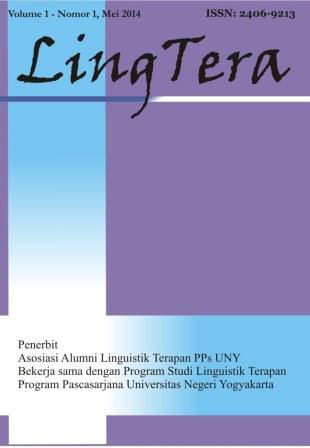Interpersonal meaning breadth variation in simultaneous interpreting English – bahasa Indonesia dienic texts: A contrastive-translational mood grammar analysis
DOI:
https://doi.org/10.21831/lt.v7i1.15756Keywords:
interpersonal meaning, MOOD, modality, dienic textsAbstract
This study presents a contrastive-translational MOOD grammar analysis of the realization of interpersonal meaning in Joyce Meyer's English sermon text and Jose Carol's Bahasa Indonesia interpreted text. Interpersonal meaning in the framework of Systemic Functional Linguistics (SFL), the model of Translational Semiotic Communication (TSC) and the model of text type and language function are the theoretical foundations of this study. This study used a descriptive qualitative-quantitative approach, involving the analysis of MOOD and Modality of the data which were translationally related semantic units grammatically expressed by MOOD clause units. The analysis reveals that the texts in this study can be classified as dienic texts with Declaratives and Imperatives as the prominent clauses, while Modality elements realized in T1 were generally realized in T2 in the same types. Declaratives and Imperatives respectively serve the informative and operative function of the texts, and the Modality elements which are mostly of a high degree and expressed explicitly give values to these functions.
References
Amalia, C., & Tou, A. (2016). Textual function variations of foreign embassies' press releases and
their implications for translation teaching. LingTera, 3(2), 130-141. doi:http://dx.doi.org/10.21831/lt.v3i2.11111
Anderson, K. C. (2006). Choosing to preach. Michigan: Zondervan.
Anderson, L. (1994). Simultaneous interpretation: Contextual and translation aspects. In S. Lambert & B. Moser-Mercer (Eds.), Bridging the gap: Empirical research in simultaneous interpretation (pp. 101-120). Amsterdam: John Benjamins Publishing Co.
Butt, D., Fahey, R., Feez, S., Spinks, S., & Yallop, C. (2000). Using functional grammar: An explorer's guide (2nd ed.). Sidney: Macquarie University.
Cameron, D. (2007). The teacher's guide to grammar. Oxford: Oxford University Press.
Eggins, S. (2004). An introduction to systemic functional linguistics (2nd ed.). London: Continuum international Publishing Group.
Flick, U. (2002). An introduction to qualitative research (2nd ed.). London: Sage Publications.
Halliday, M. A. K. (1989). Spoken and written language (2nd ed.). Oxford: Oxford University Press.
Halliday, M. A. K., & Matthiessen, C. M. I. M. (2004). An introduction to functional grammar (3rd Ed.). London: Hodder Arnold.
Halliday, M. A. K., & Matthiessen, C. M. I. M. (2013). Meaning as choice. In L. Fontaine, T. Bartlett & G. O'Grady (Eds.), Systemic functional linguistics: Exploring choice (pp. 15-36). Cambridge: Cambridge University Press.
Halliday, M. A. K., & Matthiessen, C. M. I. M. (2014). Halliday's introduction to functional grammar (4th ed.). Oxon: Routledge.
Halliday, M. A. K.. (2002). On grammar (J. Webster, Ed.). London: Continuum.
Hatim, B. (2013). Teaching and researching translation (2nd ed.). New York: Routledge.
Hatim, B., & Mason, I. (1997). The translator as communicator. London: Routledge.
Hatim, B., & Munday, J. (2004). Translation: An advanced resource book. New York: Routledge.
Kesuma, T. M. J. (2009). Metode linguistik menurut perspektif Dr. Sudaryanto. In P. Ari Subagyo & S. Macaryus (Eds.), Peneroka hakikat bahasa (pp. 15-25). Yogyakarta: Penerbit Universitas Sanata Dharma.
Lloyd-Jones, D. M. (1972). Preaching and preachers. Michigan: Zondervan Publishing House.
Lock, G. (1996). Functional English grammar: An introduction for second language teachers. Cambridge: Cambridge University Press.
Nathan, R (Rev.). (1998). The way forward. In Bishop Joe Aldred (Ed.), Preaching with Power: Sermons by Black Preachers (pp.1-7). London: Cassell.
O'Connell, D.C., & Kowal, S. (2008). Communicating with one another: Toward a psychology of spontaneous spoken discourse. New York: Springer.
Pí¶chhacker, F. (2011). Researching interpreting: Approaches to inquiry. In B. Nicodemus & L. Swabey (Eds.), Advances in interpreting research: Inquiry in action (pp. 5-25). Amsterdam: John Benjamins Publishing Co.
Porcar, C. (2011). Sign and meaning: a semiotic approach to communication. Journal for Communication and Culture 1, 1, 20-29. Retrieved on 15 December 2016, from http://www.jcc.icc.org.ro/ wp-content/uploads/2011/06/JCC-1-2011-20-29.pdf
Sujatna, E. T. S. (2012). Applying systemic functional linguistics to Bahasa Indonesia clauses. International Journal of Linguistics, 4(2), 134-146. Retrieved on 15 December 2017, doi: 10.5296/ijl.v4i2.1506.
Tou, A. B. (1997). Translational semiotic communication: A transdisciplinary perspective. Unpublished doctoral dissertation. Macquarie University.
Tou, A. B. (2005). Ihwal translation/ translating versus interpreting dalam kajian translasi. Makalah disajikan dalam Seminar tentang Penerjemahan di Kopertis Wilayah I, NAD – Sumut.
Downloads
Published
How to Cite
Issue
Section
Citation Check
License
LingTera allows readers to read, download, copy, distribute, print, search, or link to its articles' full texts and allows readers to use them for any other lawful purpose. The journal allows the author(s) to hold the copyright without restrictions. Finally, the journal allows the author(s) to retain publishing rights without restrictions.
- Authors are allowed to archive their submitted articles in an open-access repository.
- Authors are allowed to archive the final published article in an open-access repository with an acknowledgment of its initial publication in this journal.

Psychology, Evaluation, and Technology in Educational Research is licensed under a Creative Commons Attribution-ShareAlike 4.0 International License.
Based on a work at https://petier.org/index.php/PETIER.









